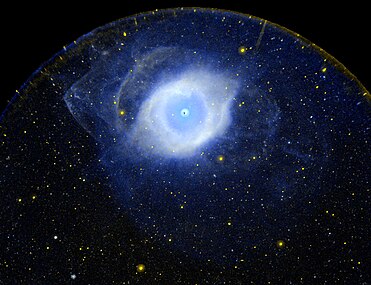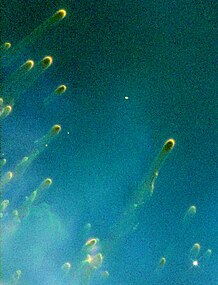Helixnebel
| Planetarischer Nebel Helixnebel | |
|---|---|
 | |
| Überlagerte Aufnahme des Hubble-Weltraumteleskops und des 4-m-Teleskops des Cerro Tololo Inter-American Observatory | |
| AladinLite | |
| Sternbild | Wassermann |
| Position Äquinoktium: J2000.0 | |
| Rektaszension | 22h 29m 38,55s [1] |
| Deklination | −20° 50′ 13,6″[1] |
| Erscheinungsbild | |
| Scheinbare Helligkeit (visuell) | 7,3 mag [2] |
| Scheinbare Helligkeit (B-Band) | 7,5 mag [2] |
| Winkelausdehnung | 16′ × 28′ [2] |
| Zentralstern | |
| Bezeichnung | WD 2226-210 |
| Scheinbare Helligkeit | 13,2 mag |
| Physikalische Daten | |
| Rotverschiebung | (−50 ± 33) · 10−6 [1] |
| Radialgeschwindigkeit | (−15 ± 10) km/s [1] |
| Entfernung | 651 ± 6 Lj |
| Geschichte | |
| Entdeckung | Karl Ludwig Harding |
| Datum der Entdeckung | September 1823[3] |
| Katalogbezeichnungen | |
| NGC 7293 • PK 36-57.1 • ESO 602-PN22 • GC 4795 • BD -21 6239 | |
Der Helixnebel (auch NGC 7293 oder Auge Gottes) ist ein Planetarischer Nebel im Sternbild Wassermann mit einer Helligkeit von 6,30 mag und einem scheinbaren Durchmesser von 16 × 28 Winkelminuten. Er wurde im Jahr 1823 von dem deutschen Astronomen Karl Ludwig Harding entdeckt.
Der Helixnebel ist mit einer Entfernung von etwa 650 Lichtjahren einer der nächsten planetarische Nebel und damit einer der mit dem größten scheinbaren Durchmesser. Daher können in seiner Hülle auch Details der Gasstruktur aufgelöst werden.
Mit dem Hubble-Teleskop war es 1996 sogar erstmals möglich, Knoten in der Hülle aufzunehmen, die vorher unbekannt waren und neue Rückschlüsse auf die Entstehung planetarischer Nebel erlaubten. Sie warfen aber auch neue Fragen auf. So ist nicht klar, ob die Knoten-Keime während des Auswurfs der Hülle entstanden oder ob sie von Aktivität des Sterns vor dem Auswurf stammen. Auch ist umstritten, ob die Knoten hydrodynamische Strukturen sind (d. h. durch Instabilitäten erzeugt) oder ob sie durch Photoionisation des Gases durch den Weißen Zwerg im Zentrum entstehen.
Der Nebel wird auch als Auge Gottes bezeichnet, insbesondere seit nach der Veröffentlichung einer Hubble-Aufnahme des Nebels 2003 sich im Internet das Gerücht verbreitete, dass die Aufnahme des Nebels ein Ereignis zeigte, das nur alle 3000 Jahre auftrete.[4]
- UV-Aufnahme: 135...270 nm (GALEX)
- IR-Aufnahme: blau 3,6...4,5 µm, grün 5,8...8 µm, rot 24 µm (Spitzer Space Telescope)
- Knoten im Inneren des Helixnebels (Detailaufnahme Hubble)
- Strukturen des Helixnebels.
Literatur
- König, Michael & Binnewies, Stefan (2023): Bildatlas der Sternhaufen & Nebel, Stuttgart: Kosmos, S. 240
Weblinks
- Spitzer Space Telescope
- SEDS
- The Eye of God, Eintrag zum Gerücht, das den Namen Auge Gottes erzeugte.
- Spektrum.de: Amateuraufnahmen [1][2][3]
Einzelnachweise
- ↑ a b SIMBAD-Datenbank
- ↑ a b Students for the Exploration and Development of Space
- ↑ https://cseligman.com/text/atlas/ngc72a.htm#7293
- ↑ Florian Rötzer: Der Helixnebel oder das Auge Gottes, in: Telepolis, 26. Mai 2009 (abgerufen 17. Mai 2014).
Auf dieser Seite verwendete Medien
This infrared image from NASA's Spitzer Space Telescope shows the Helix Nebula, a cosmic starlet often photographed by amateur astronomers for its vivid colors and eerie resemblance to a giant eye.
The nebula, located about 700 light-years away in the constellation Aquarius, belongs to a class of objects called planetary nebulae. Discovered in the 18th century, these colorful beauties were named for their resemblance to gas-giant planets like Jupiter.
Planetary nebulae are the remains of stars that once looked a lot like our sun. When sun-like stars die, they puff out their outer gaseous layers. These layers are heated by the hot core of the dead star, called a white dwarf, and shine with infrared and visible colors. Our own sun will blossom into a planetary nebula when it dies in about five billion years.
In Spitzer's infrared view of the Helix nebula, the eye looks more like that of a green monster's. Infrared light from the outer gaseous layers is represented in blues and greens. The white dwarf is visible as a tiny white dot in the center of the picture. The red color in the middle of the eye denotes the final layers of gas blown out when the star died.
The brighter red circle in the very center is the glow of a dusty disk circling the white dwarf (the disk itself is too small to be resolved). This dust, discovered by Spitzer's infrared heat-seeking vision, was most likely kicked up by comets that survived the death of their star. Before the star died, its comets and possibly planets would have orbited the star in an orderly fashion. But when the star blew off its outer layers, the icy bodies and outer planets would have been tossed about and into each other, resulting in an ongoing cosmic dust storm. Any inner planets in the system would have burned up or been swallowed as their dying star expanded.
So far, the Helix nebula is one of only a few dead-star systems in which evidence for comet survivors has been found.
This image is made up of data from Spitzer's infrared array camera and multiband imaging photometer. Blue shows infrared light of 3.6 to 4.5 microns; green shows infrared light of 5.8 to 8 microns; and red shows infrared light of 24 microns.These gigantic, tadpole-shaped objects are probably the result of a dying star's last gasps. Dubbed "cometary knots" because their glowing heads and gossamer tails resemble comets, the gaseous objects probably were formed during a star's final stages of life.
Hubble astronomer C. Robert O'Dell and graduate student Kerry P. Handron of Rice University in Houston, Texas discovered thousands of these knots with the Hubble Space Telescope while exploring the Helix nebula, the closest planetary nebula to Earth at 450 light-years away in the constellation Aquarius. Although ground-based telescopes have revealed such objects, astronomers have never seen so many of them. The most visible knots all lie along the inner edge of the doomed star's ring, trillions of miles away from the star's nucleus. Although these gaseous knots appear small, they're actually huge. Each gaseous head is at least twice the size of our solar system; each tail stretches for 100 billion miles, about 1,000 times the distance between the Earth and the Sun. Astronomers theorize that the doomed star spews hot, lower-density gas from its surface, which collides with cooler, higher-density gas that had been ejected 10,000 years before. The crash fragments the smooth cloud surrounding the star into smaller, denser finger-like droplets, like dripping paint.
This image was taken in August, 1994 with Hubble's Wide Field Planetary Camera 2. The red light depicts nitrogen emission ([NII] 6584A); green, hydrogen (H-alpha, 6563A); and blue, oxygen (5007A).Autor/Urheber: Roberto Mura, Lizenz: CC BY-SA 3.0
Caldwell Catalogue objects.
Ultraviolet image of the planetary nebula NGC 7293 also known as the Helix Nebula. It is the nearest example of what happens to a star, like our own Sun, as it approaches the end of its life when it runs out of fuel, expels gas outward and evolves into a much hotter, smaller and denser white dwarf star.
Helix Nebel mit Strukturen
The Helix Nebula: a Gaseous Envelope Expelled By a Dying Star
- About the Object
- Object Name: Helix Nebula, NGC 7293 or "The Eye of God"
- Object Description: Planetary Nebula
- Position (J2000): R.A. 22h 29m 48.20s
- Dec. -20° 49' 26.0"
- Constellation: Aquarius
- Distance: About 690 light-years (213 parsecs)
- Dimensions: The image is roughly 28.7 arcminutes (5.6 light-years or 1.7 parsecs) across.
- About the Data
- Instruments: ACS/WFC on Hubble Space Telescope (HST) and Mosaic II Camera on CTIO 4m telescope
- Exposure Time: 4.5 hours (HST) and 10 minutes (CTIO)
- Filters: F502N ([O III]) and F658N (Ha) (for the HST); c6009 (H alpha)and kc6014 ([O III]) for the CTIO
- Image properties
- Centered on white dwarfed and cropped
- Downsampled to 3200x3200
- Saved as jpg, quality 8/10, 5 scans
- Stitching errors manually fixed










